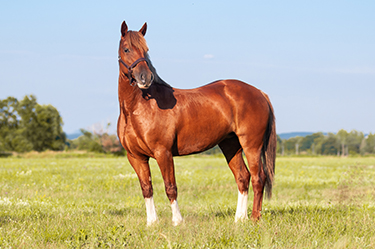Are Your Clients Aware That Horses Get Sunburns, Too?

It’s the time of year when the days get longer and the sun gets brighter! Do your clients know that horses can get a sunburn similar to the way that people do? Passing along the following information may help to protect their animal from the hot rays of summer!
Susceptibility to Sunburn for Horses
While any horse can get a sunburn if left out unprotected, certain ones are more vulnerable to the sun’s damage. For example, pink-skinned animals are more susceptible because their skin lacks melanin, the pigment that helps to protect from the ultraviolet (UV) rays.
Without protection, a sunburn can cause severe and painful blistering, especially around the horse’s more sensitive areas, including:
- Eyes
- Muzzle
- Lips
- Nose
- Sheath
- Flanks
Clients need to learn of the ways they can protect their horse, particularly when their animal is one with:
- White facial markings
- White muzzle
- White ears
- Bald-faced horses
- Paints
- Pintos
- Double dilutes
- Appaloosas
Signs of Sunburn on Horses
Clients should know to be aware of the signs that an animal has been sunburned, including:
- Redness
- Heat
- Skin that is painful to the touch
- Blistering
- Peeling
- Scaly skin
- Head shy
When these symptoms are noted, clients should be reminded that sunburns are painful and the animal may respond negatively if being groomed, haltered, bridled, or ridden. Also, depending upon the severity, a horse with a painful sunburn should not be ridden until the pain has subsided and the damage to the skin has completely healed.
Danger of Sunburn for Horses
Clients need to be aware that if their horse becomes severely sunburned, it is important that they contact their veterinarian to determine the need of an appropriate treatment regimen.
Additionally, some horses are prone to developing a heightened skin sensitivity and reactivity to UV sunlight, called photosensitizational dermatitis. Within hours of exposure, horses developing this condition may experience:
- Photophobia and discomfort
- Lightly pigmented areas with little hair are the most severely affected, usually including:
- Muzzle
- Ears
- Eyelids
- Face
- Tail
- Vulva
- Coronary bands
- Behaviors will be indicated by scratching and rubbing the ears, eyelids, muzzle
- Affected areas may develop:
- Erythema
- Edema
- Serous exudation
- Scab formation
- Skin necrosis
One other consideration for the importance of sun protection is to explain to clients that, similar to people, a sunburn can predispose a horse to developing cancerous squamous cell carcinoma.
Prevention of Sunburn on Horses
Advise clients that taking steps towards sunburn prevention is the best plan to follow. Provide tips, such as:
- Use UV-resistant coverings when possible to block the damaging rays from reaching the animal, such as:
- Fly masks
- Some can be purchased with a muzzle cover which provide extra protection around the nostrils and mouth
- Sun-protecting sheets
- Choose lightweight and comfortable ones designed for use during hot temperatures
- Leg protection
- Apply sunscreen frequently, but not around the eyes
- Use of colored sunblock makes it easier to see areas that have been rubbed off
- Provide shade and shelter or stable the animal inside on sunny days, 10 a.m. to 3 p.m. if they have no access to shade.
Sunscreen, sunglasses, hats, and cover-ups are the items most people use to protect themselves from the harsh summer sun. While most of us have learned how to stay comfortable and sun-safe when out-of-doors, chances are that little consideration has been given to providing the same protection to the horses out in the paddock.
For other ways to protect horses from sunburn, contact your Covetrus representative at 855.724.3461.
Sources:http://www.thehorse.com/articles/26813/sunburn-and-photosensitivity-in-horses
http://www.ars.usda.gov/research/publications/publications.htm?SEQ_NO_115=135844

Working Here
Our team members are encouraged to be the best they can be... at Covetrus we believe we impact one another.
Learn MoreNews & Events
FDA Cautions Pet Owners Not to Feed Texas Tripe Inc. Raw Pet Food Due to Salmonella, Listeria Monocytogenes
The U.S. Food and Drug Administration is cautioning pet owners not to feed their pets any of the Texas Tripe brand raw frozen pet food listed below because several samples of Texas Tripe raw pet food have tested positive for Salmonella and/or L. mono.
Careers
Are you looking for a place to let your talents shine? At Covetrus, we help our practitioner customers better serve their patients and take pride in providing the best customer experience possible. Search our open positions to see our available opportunities.
Newsletter
Stay current with what’s going on with Covetrus, subscribe to receive our newsletter and email communications. Subscribers will receive the latest information in practice management, sales and marketing, animal health, and more.



-3-(1).png?sfvrsn=2d806d73_0)

Leave a comment